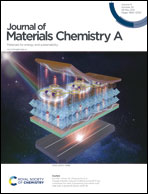A silicon-based hybrid photocathode modified with an N5-chelated nickel catalyst in a noble-metal-free biomimetic photoelectrochemical cell for solar-driven unbiased overall water splitting†
Abstract
Modification of the surface of semiconductor-based photoelectrodes with molecular redox catalysts provides a way to realize atom-efficient catalysis for photoelectrochemical (PEC) H2 and O2 evolution. However, the diversity of immobilized molecular catalysts for the reported hybrid photocathodes is very limited to date, and most of the semiconductor/molecular catalyst hybrid photocathodes still suffer from low efficiency and poor stability. This work demonstrates that the efficiency and stability of a silicon-based photocathode for PEC H2 production were substantially improved by surface modification with N5-chelated nickel and cobalt catalysts (denoted as M(N5)HA, M = Ni, Co) through a hydroxamate anchor (HA). Compared to previously reported molecular catalyst-modified planar p-Si photocathodes, p-Si/TiO2/Ni(N5)HA displayed higher photocurrent density (up to −1.54 mA cm−2) and superior stability for PEC H2 production at 0 V vs. RHE under simulated 1 sun illumination. Furthermore, a noble-metal-free biomimetic Z-scheme PEC cell was assembled by coupling the newly-built p-Si/TiO2/Ni(N5)HA photocathode with a Co4O4 cubane-modified BiVO4 photoanode. This fully molecular PEC cell produced H2 and O2 in a molar ratio of 2 : 1 from water under illumination at zero bias voltage, achieving a solar-to-hydrogen efficiency of 0.04%, which is the highest efficiency reported so far for molecular catalyst-modified water splitting PEC cells. This is the first efficient noble-metal-free PEC cell assembled with two molecular catalyst-modified hybrid photoelectrodes, either with or without dye sensitization, for unbiased overall water splitting under illumination.



 Please wait while we load your content...
Please wait while we load your content...